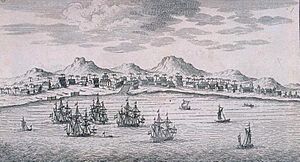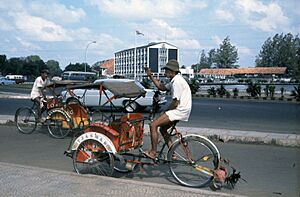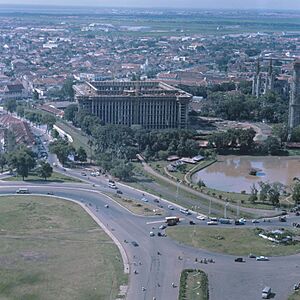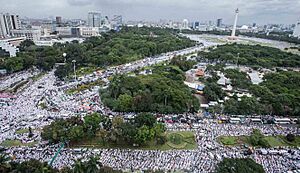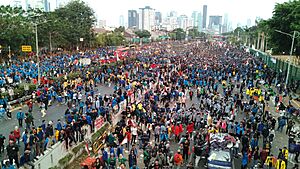History of Jakarta facts for kids

Jakarta is Indonesia's capital and largest city. It sits on the northwestern part of Java, where the Ciliwung River meets the sea (this is called an estuary). People have lived here for a very long time. We have historical proof that Jakarta was a Hindu settlement and port way back in the 4th century CE.
Over time, different groups have controlled the city. These include the Indianized kingdom of Tarumanegara, the Hindu Kingdom of Sunda, the Muslim Sultanate of Banten, and then the Dutch, Japanese, and Indonesian governments. The Dutch East Indies built up the area a lot before Japan took it during World War II. Finally, it became independent as part of Indonesia.
Jakarta has had many names. It was called Sunda Kalapa during the Kingdom of Sunda. Then it was known as Jayakarta, Djajakarta, or Jacatra when the Banten Sultanate was in charge. Later, under the Dutch, it was called Batavia (from 1619 to 1945). During the Japanese occupation and in modern times, it has been known as Djakarta or Jakarta.
For more details about Jakarta's history before Indonesia became independent, you can look up Batavia, Dutch East Indies.
Contents
- Early Kingdoms: Jakarta's First Traces (4th Century AD)
- Kingdom of Sunda: A Busy Trading Port (669–1527)
- Banten Sultanate: Jayakarta is Born (1527–1619)
- Dutch Batavia: A New City Rises (1610–1942)
- Japanese Occupation: A Time of Change (1942–1945)
- National Revolution: Fighting for Freedom (1945–1949)
- Independent Nation: Jakarta in the 1950s
- Sukarno's Grand Projects: Building a New Image (1960–1965)
- Ali Sadikin's Era: Improving Jakarta (1966 – late 1970s)
- Economic Growth: The Late 1970s and 1980s
- Jakarta from the 1980s to Today
- See also
Early Kingdoms: Jakarta's First Traces (4th Century AD)
The coastal area and port of Jakarta in northern West Java have been home to people since the 4th century BCE, linked to the ancient Buni culture. The oldest historical record found in Jakarta is the Tugu inscription. This important stone carving was discovered in Tugu sub-district, North Jakarta. It is one of the oldest inscriptions in Indonesian history. At that time, the area was part of the Indianized kingdom of Tarumanagara.
In AD 397, King Purnawarman created a new capital city for his kingdom called Sunda Pura. It was located on the northern coast of West Java. The capital of the Tarumanagara kingdom was likely somewhere between Tugu sub-district in North Jakarta and Bekasi Regency in West Java. King Purnawarman left seven special memorial stones across the area. These stones, found in places like present-day Banten and West Java provinces, have inscriptions with his name on them.
Kingdom of Sunda: A Busy Trading Port (669–1527)

After the Tarumanagara kingdom became less powerful, its lands became part of the Kingdom of Sunda. A Chinese book from the early 13th century, called Chu-fan-chi, says that the kingdom of Srivijaya (based in Sumatra) ruled Sumatra, the Malay peninsula, and western Java (which was known as Sunda). The book described the port of Sunda as important and busy, with its pepper being famous for its excellent quality. The people there worked in farming, and their homes were built on wooden stilts.
One of the ports at the mouth of the Ciliwung River was renamed Sunda Kelapa or Kalapa (meaning "Coconut of Sunda"). This name is found in old Hindu manuscripts. This port was important for Pakuan Pajajaran (which is now Bogor), the capital of the Sunda Kingdom. By the 14th century, Sunda Kelapa had become a major trading port for the kingdom.
European explorers in the 16th century also wrote about a city called Kalapa. It seemed to be the main port for the Hindu kingdom of Sunda. In 1522, the Portuguese made a special agreement called Luso Sundanese padrão with the Sunda Kingdom, which controlled the port. The king of Sunda, Prabu Surawisesa, allowed the Portuguese to trade pepper freely. In return, the Portuguese promised military help against the rising Islamic Demak Sultanate. Portuguese people who worked for the king even made their homes in Sunda Kelapa.
Banten Sultanate: Jayakarta is Born (1527–1619)
To stop the Portuguese from gaining a strong position on Java, Fatahillah, representing the Sultanate of Demak, attacked the Portuguese in Sunda Kelapa in 1527. He successfully took control of the harbor on June 22. After this victory, Sunda Kelapa was renamed Jayakarta. Later, this port became part of the Sultanate of Banten, which was located west of Jayakarta.
By the late 16th century, Jayakarta was under the rule of the Sultanate of Banten. Prince Jayawikarta, who followed the Sultan of Banten, set up a settlement on the west side of the Ciliwung River. He built a military post there to control the port at the river's mouth.
Dutch Batavia: A New City Rises (1610–1942)
The Dutch started trading in the East Indies in 1595. For the next 25 years, there was competition between the Dutch and the British. There was also conflict between the Sultanate of Banten and Prince Jayawikarta.
Dutch East India Company: A Trading Empire (1610–1800)
In 1602, the Dutch government gave a special right to the Dutch East India Company (VOC) to control all trade in Asia. In 1603, the first permanent Dutch trading post in Indonesia was set up in Bantam, West Java. In 1610, Prince Jayawikarta allowed Dutch traders to build a wooden warehouse and houses on the east bank of the Ciliwung River, across from Jayakarta. This outpost was built in 1611.
The competition ended in 1619 when the Dutch became closer with Banten. They used military force in Jayakarta and took control of the port after destroying the existing city. The new city built on this spot was officially named Batavia on January 18, 1621. From here, the Dutch East Indies eventually ruled the entire region. Batavia, under the VOC, was like a company town. It was managed by a governor-general in Batavia and a board of directors in Amsterdam. Their main goal was to help Dutch merchants, especially with the spice trade between Europe and the Moluccas. The main office of this new town was the Batavia Castle.
During the VOC era, Batavia was centered around the "Lower City." This included the walled area called Kota, the old harbor at Sunda Kelapa, and the Chinese quarter at Glodok. By the mid-18th century, Batavia also included areas outside the city walls. These were along the Molenvliet canal (now Jalan Gajah Mada and Jalan Hayam Wuruk), Noordwijk (now Jalan Juanda), Rijswijk (now Jalan Veteran), along Gunung Sahari, and Jacatraweg (Jalan Pangeran Jayakarta). The markets at Tanah Abang and Senen, which are Jakarta's oldest markets, were also part of it.
Batavia was controlled by the VOC until the company went bankrupt. Its special trading rights ended in 1799.
Dutch East Indies: Colony Capital (1800–1942)
After the Vereenigde Oost-Indische Compagnie (VOC) went bankrupt and closed down in 1800, the Dutch government took over its debts and properties. All of the VOC's land claims became a full colony called the Dutch East Indies. Batavia changed from being just a company's main office to the capital of this colony. The city slowly grew towards the south.
During this time, government buildings were moved to an area called Weltevreden. This was south of the Koningsplein, the Waterlooplein, and Rijswijk (Jalan Veteran). Weltevreden, which included Koningsplein, Rijswijk, Noordwijk, Tanah Abang, Kebon Sirih, and Prapatan, became a popular place for European people to live, have fun, and shop. The name Weltevreden was used until 1931, when it officially became known as Batavia Centrum (Central Batavia).
This period also saw the development of the Pasar Baru market in the 1820s. The Tanjung Priok port was finished in 1886. The garden cities of Menteng and Gondangdia were developed in the 1910s. And Meester Cornelis (now Jatinegara) became part of Jakarta in 1935.
Japanese Occupation: A Time of Change (1942–1945)
On March 5, 1942, Batavia was taken by the Japanese army. The Dutch officially gave up to the Japanese forces on March 9, 1942. Control of the colony was then given to Japan. The city was renamed Jakarta (officially Jakaruta tokubetsu-shi, meaning "Special Municipality of Jakarta"). This showed that the city had a special status.
To make their control stronger in Indonesia, the Japanese government created a new system for local government. This system divided Java into several Syuu (like provinces), each led by a Bupati (Regent). Each Syuu was divided into several Shi (like municipalities), led by Wedanas (District Heads). Below them were Assistant Wedanas (Sub-district Heads), who oversaw Lurahs (Village Unit Heads). And below them were Kepala Kampungs (Kampung Chiefs).
A schichoo (Mayor) was in charge of all these officials. This system meant that one person had a lot of power, and there were no councils or groups to represent the people. The first mayor of Jakarta under the Japanese was Tsukamoto, and the last was Hasegawa.
Life in Indonesian cities, including Jakarta, became harder during the occupation. The economy suffered, and buildings were damaged. Beautiful colonial buildings and hotels were turned into military barracks. Many buildings were vandalized because metal was needed for the war. Many iron statues from the Dutch colonial period were taken away by the Japanese soldiers. For example, the statue of Jan Pieterszoon Coen at Waterlooplein was destroyed during the Japanese occupation.
In 1943, the Japanese government slightly changed how Jakarta was run. They added a special advisory group. This group had twelve local Javanese leaders who were seen as loyal to the Japanese. Among them were Suwiryo (who became the vice mayor for Jakarta) and Dahlan Abdullah.
National Revolution: Fighting for Freedom (1945–1949)
After Japan lost the war in 1945, the area went through a time of big changes as Indonesia fought for its independence. During the Japanese occupation, and from the point of view of the Indonesian nationalists who declared independence on August 17, 1945, the city was renamed Jakarta. After the war, the Dutch name Batavia was still used internationally until Indonesia became fully independent on December 27, 1949. Then, Jakarta was officially announced as the national capital of Indonesia.
After the Japanese surrendered, Indonesia declared its independence on August 17, 1945. This important announcement happened at Jalan Pegangsaan Timur No. 56 (now Jalan Proklamasi), Central Jakarta. Suwiryo was the chairman of the committee. Suwiryo was recognized as the first mayor of Jakarta Tokubetsu Shi. This position was soon changed to Pemerintah Nasional Kota Jakarta ("Jakarta City National Administration").
On September 19, 1945, Sukarno gave a speech about Indonesian independence and against colonialism. This happened during a big meeting called Rapat Akbar at Lapangan Ikada, which is now Merdeka Square. This big meeting marked the beginning of a period of national revolution in Indonesia.
On September 29, 1945, British and Dutch troops arrived in Jakarta. Their goal was to disarm the Japanese soldiers and send them home. They also planned to take back control of the colony. On November 21, 1945, Suwiryo and his helpers were arrested by members of the Netherlands Indies Civil Administration.
On January 4, 1946, Indonesian Republicans left Jakarta, which was occupied by the Allies. They set up their capital in Yogyakarta. There wasn't much war in Jakarta itself, and the city continued to develop as the Dutch tried to regain control. In 1947, the Dutch successfully put in place new rules for city development. These rules had been planned before the war. Batavia was planned to grow with a new satellite city 8 kilometers south of the Koningsplein. This 730-hectare area would become the Kebayoran satellite city. It was the first major city planning project in Indonesia after World War II.
On December 27, 1949, the Dutch recognized Indonesia as an independent country and a sovereign federal state called the "Republic of the United States of Indonesia". At this time, the Jakarta City Administration was led by Mayor Sastro Mulyono.
Independent Nation: Jakarta in the 1950s
City Growth and New Areas
After Indonesia's independence was recognized on December 27, 1949, Jakarta's size grew greatly in March 1950. It expanded from 182 square kilometers to 530 square kilometers. Even with this big increase in size, the number of people living in the city didn't change much at first. Jakarta's population was 1,340,625 in 1949, grew to 1,432,085 in 1950, and then to 1,661,125 in 1951. The new areas added to Jakarta at that time were mostly rural and didn't have many people.
Kebayoran Baru was still a satellite city of Jakarta and was located outside Jakarta's main boundaries. The building of major roads like Jalan Thamrin and Jalan Sudirman had started in 1949. These roads would only be opened in 1953.
Developing the City
Jakarta in the 1950s was quite similar to the colonial period. Banking areas were still in Kota, around Kali Besar and Jalan Pintu Besar Utara. Chinese businesses were mainly in Glodok, especially Pintu Kecil. The old markets like Pasar Baru, Pasar Senen, and Glodok were still the busiest in Jakarta. European shopping and entertainment areas were still centered at Harmoni Junction. Most colonial hotels kept their Dutch names, such as Hotel des Indes (or Hotel Duta Indonesia) and Hotel der Nederlanden (or Hotel Dharma Nirmala). Kemayoran airport handled both flights within Indonesia and international flights.
In 1950, Jakarta's main urban area was enclosed by the city's railway network. Areas beyond the railway lines were empty, like Tomang and Grogol to the west, and Pluit and the swampy Ancol to the north. Areas to the east and northeast, such as the land between Jalan Gunung Sahari and Tanjung Priok, remained rural. The Kali Sunter (Sunter River) was in the countryside and would not be developed into a residential area until the 1970s.
Some new suburbs developed in the 1950s included Grogol, Tanah Tinggi, Bendungan Hilir, and Pejompongan. These were mostly built to provide homes for government workers.
Even though city development was slow, the early 1950s saw the building of important structures. These would create a base for Jakarta's fast growth in the 1960s. Jalan Thamrin and Jalan Sudirman were built between 1949 and 1953 to connect Central Jakarta with Kebayoran Baru. These projects were often a team effort between the Dutch and Indonesians. The first buildings along Thamrin-Sudirman were the Bank Indonesia headquarters (1958-1962), Hotel Indonesia (1959-1962), and the Welcome Monument. At that time, Jalan Sudirman was mostly rural with no buildings until the 1970s, except for the Gelora Bung Karno sports complex.
Taking Over Dutch Properties
After Indonesia's independence was recognized on December 27, 1949, the change from Dutch to Indonesian leadership happened quickly. Dutch homes and properties were taken over by the Indonesian government. Some important buildings that changed hands were:
- The Governor-general's palace on Jalan Merdeka Utara became the Istana Merdeka presidential palace.
- The Concordia military social club building on Jalan Lapangan Banteng Timur became the national parliament until early 1965.
- The Volksraad (People's Council) at Jalan Pejambon, which had been the military commander's home, became the Ministry of Foreign Affairs.
- The Binnenlands Bestuur (internal administration) headquarters on Jalan Medan Merdeka Utara became the Ministry of Home Affairs.
- The Ministry of Finance moved to the grand Witte Huis on Jalan Lapangan Banteng Timur.
- The Jakarta City Council chambers on Jalan Medan Merdeka Selatan remained the home of the Jakarta City Council. The difference was that the council was now all Indonesian and led by an Indonesian mayor. The title "mayor" would change to "governor" in 1960.
- The old STOVIA medical school became the medical faculty at the newly created University of Indonesia.
- The colonial ANETA news agency on Jalan Antara was taken over by Indonesian owners and managers between 1951 and 1955. It was a step towards the current government-owned news agency, ANTARA.
Even though many government departments changed to Indonesian control, the economic change was much slower. The Dutch still owned key parts of Indonesia's economy for most of the 1950s, including banks, oil, and shipping. It was only in late 1957 that Indonesia started taking over Dutch properties. This was partly because of anger over the Netherlands' refusal to give Irian Jaya to Indonesia. By 1960, almost all Dutch properties in Indonesia had been taken over, and Dutch citizens were asked to leave Indonesia.
Dutch Departure and Population Boom
The departure of the Dutch caused huge social changes in Jakarta. In mid-1952, 48,280 foreigners (not including Chinese people) lived in Jakarta. Of these, 90.2% were Dutch. By the end of the 1950s, only a few hundred Dutch people remained in Jakarta. The 1960s was a time when foreigners were no longer a common sight on Jakarta's streets.
The Dutch leaving also caused many people from rural areas to move to Jakarta. They believed the city offered more chances for jobs. As a result, the kampung (village) areas in Jakarta grew very quickly. There weren't enough houses, schools, medical services, water, or electricity. In 1951 and 1952, 25 hectares of land were opened for housing in Grogol, 25 hectares in Tanah Tinggi (just south of Kemayoran Airport), and 25 hectares in Pejompongan. Another 15 hectares in Pejompongan were set aside for a water purification plant. The 730-hectare satellite city of Kebayoran Baru, planned by the Dutch in the 1930s, remained the most important housing development in Jakarta in the 1950s.
City Transportation
Jakarta's tram system started in 1869 with horse-drawn trams and later used electric trams from 1899. However, it faced competition from buses and had money problems. President Sukarno didn't think trams were good for Jakarta, so he gradually stopped their operation. By April 1960, tram lines only ran from Senen and Kramat to Jatinegara. By 1962, trams had completely disappeared from Jakarta.
The 1950s was known as the decade when the informal becak (a type of pedicab) became very common in Jakarta. Introduced to Jakarta in the 1930s, the number of becaks greatly increased in the late 1940s. This happened at the same time as many people moved to Jakarta looking for work. In 1953, 31,000 becaks were officially registered.
Idea to Move the Capital
In the mid-1950s, some people suggested moving the capital city. This was because they felt there was corruption and too much government money was being spent in Jakarta. Takdir Alisjahbana, for example, described the city in a very negative way. However, by 1957, these ideas were dropped. Instead, the city's boundaries were made larger, and it became the Daerah Khusus Ibukota (DKI), or Special Capital Territory. This made it one of the provinces of Indonesia.
Sukarno's Grand Projects: Building a New Image (1960–1965)
Monumental Buildings and Landmarks
Jakarta's skyline changed dramatically between 1960 and 1965. President Sukarno, who was also an architect and city planner, personally pushed the city to become a modern capital. He wanted it to be a source of pride for Indonesia and a "beacon" (mercusuar) for a powerful new nation. This short period gave Jakarta many of its most famous modern landmarks and monuments.
Sukarno had already shifted the country to "Guided Democracy" between 1957 and 1959, which greatly increased his political power. His strong power allowed him to win the bid for Indonesia to host the 1962 Asian Games in Jakarta. This event was used as a reason to complete new landmarks in Jakarta. So, the first half of the 1960s saw many large government-funded projects built with a strong nationalistic style. By working on these hopeful and grand projects, Sukarno aimed to show the newly independent nation's pride to the world.
Sukarno filled Jakarta with many monuments. Many grand projects were thought of, planned, and started during his time as leader. Some of the notable projects from the first half of the 1960s included: the Semanggi "clover-leaf" highway interchange; wide avenues in Central Jakarta (Jalan M.H. Thamrin and Jalan Jenderal Sudirman), and Jalan Gatot Subroto; a wide bypass connecting Tanjung Priok harbor with Halim Airport (Jalan Jenderal Ahmad Yani); four tall hotels, including Hotel Indonesia; a new parliament building (DPR/MPR Building); a stadium (Bung Karno Stadium); the Sarinah Department Store; the development of Ancol on Jakarta's north coast to become a major recreation complex; the largest mosque in Southeast Asia; and the widening of Jalan Thamrin and Jalan Sudirman before the 1962 Asian Games.
Most of Jakarta's monuments were started in the first half of the 1960s. These include the National Monument, Selamat Datang Monument, Pemuda Monument at Senayan, Irian Jaya Liberation Monument at Lapangan Banteng, and the Dirgantara Monument at Pancoran.
During the first half of the 1960s, government projects in Jakarta were so intense that regular citizens found it hard to get cement and building materials for their own use.
New Neighborhoods Emerge
In the early 1960s, more people started using cars. This allowed the city to grow beyond the limits of the railway network. Several neighborhoods began to develop far from the city center. Some of these included Grogol to the west, which was planned as a flood-proof residential area in the 1950s but was immediately flooded in February 1960. There were also new homes west of Kemayoran Airport. New housing developments appeared west of Jalan Gajah Mada (Tanah Sereal, Krukut, Krendang, and Duri) and east of Jalan Hayam Wuruk (Mangga Besar and Sawah Besar). Several residential projects that started in the 1950s began to take shape in the 1960s. Among these were Pejompongan (land opened in 1952), Bendungan Hilir, Setiabudi to the east of Jalan Sudirman, Tanah Tinggi (planned in 1951), and Rawa Sari (now Cempaka Putih Timur, planned in 1952).
Sukarno's Decline
The period of grand projects suddenly stopped after the 30 September Movement in 1965. This event marked the beginning of Sukarno losing his power. As a result, Jakarta's skyline was left with many unfinished steel and concrete buildings. A book from 1969 by the Jakarta City Government said: "Djakarta is dotted with steel skeletons and the concrete shells of unfinished buildings. There is no money to finish them. Who is able to finish and utilize these buildings?" Some of Sukarno's delayed projects in Jakarta included Wisma Nusantara, a 30-story office tower meant to be the tallest in Southeast Asia but left as an unfinished steel structure from 1966 to 1971. The Istiqlal Mosque, started in 1961, wasn't finished until 1978. The National Parliament building, started in 1965, was completed in stages until 1983. The Hotel Borobudur started in 1963 but opened in 1974. And the Balai Sarbini and Veteran's Building complex, approved in 1965, opened in 1973.
Ali Sadikin's Era: Improving Jakarta (1966 – late 1970s)
Better Roads and Services
In 1966, Ali Sadikin became the governor of Jakarta. He served from 1966 to 1977, making him Jakarta's longest-serving governor. Instead of focusing on huge, grand projects, Ali Sadikin focused on providing basic needs for Jakarta's fast-growing population. His "kampung improvement programs" were very famous. He fixed and built roads, provided public transportation, better sanitation, health services, and education for people who were not well-off.
Some of the roads built in the 1970s included Jalan Tomang Raya. This road continued from Jalan Kyai Caringin and crossed over Jalan Letnan Jenderal S. Parman into Tanjung Duren and the new housing area of Kebon Jeruk. At that time, the continuation of Jalan Tomang Raya was known as Jalan Arjuna, a smaller road. By the 1990s, it would become part of the Jakarta-Tangerang-Merak toll road. Another road built in the 1970s was Jalan H R Rasuna Said. Once finished, Rasuna Said, Sudirman, and Gatot Subroto formed the Golden Triangle of Jakarta. This area became the main business, financial, and diplomatic center of Jakarta. During this time, the first buildings appeared on Jalan Sudirman north of the Semanggi.
Even though the program was successful and won an award in 1980, it was stopped. This was because it focused too much on only improving physical structures. Sadikin also worked to improve public services, banned rickshaws, and cleared out "slum dwellers" and "street peddlers."
Finishing Old Projects
The 1970s saw the completion of projects that Sukarno had started in the 1960s.
In the early 1970s, Jalan Thamrin became a major road with buildings taller than 5 stories. Jalan Sudirman was still quite empty, except for the Gelora Bung Karno sports complex and some housing at Bendungan Hilir and Setiabudi. Monuments like the Irian Jaya Liberation Monument, the Prince Diponegoro Monument, the Heroes Monument, and the Dirgantara Monument were all finished in the early 1970s.
By the late 1970s, Ancol, another project suggested by Sukarno in the early 1960s, was already a well-known recreational area called Ancol Dreamland. It had Bina Ria beach, a golf course, swimming pools, an oceanarium, Putri Duyung Cottage, Hotel Horison and its casinos, a drive-in theater, and new housing developments on both sides.
Fairs and Fun in Jakarta
In 1968, the Jakarta Fairs began at Medan Merdeka. The Taman Ismail Marzuki cultural center at Cikini also opened. Taman Ria Remaja (Youth Recreation Park) opened in the 1970s next to the Gelora Bung Karno.
Kemayoran Airport Changes
By 1974, the improved Halim Perdanakusuma Airport became the international airport. Kemayoran then became an airport only for flights within Indonesia. In the late 1970s, some housing areas west of Kemayoran Airport, like the grid-like Pademangan, started to grow closer to the western edge of Kemayoran Airport.
Economic Growth: The Late 1970s and 1980s
Early in Ali Sadikin's time as governor, Suharto was elected president of Indonesia in 1967. He decided to encourage foreign companies to invest in Indonesia. Ali Sadikin made sure that Jakarta's infrastructure could support businesses and boost economic growth. This included building the Jakarta Convention Center (1974) and several hotels. The 1970s saw a boom in hotel construction, with nine major hotels opening: Hotel Kartika Plaza (1972), President Hotel (1973), Hotel Borobudur (1974), Hotel Ambassador/Aryaduta (1974), Hotel Sahid Jaya (1974), Hotel Kartika Chandra (1974), the Hilton Hotel (1976), Hotel Sari Pan Pacific (1976), and Mandarin Hotel (1978). Hotel Indonesia also added an extension in 1974.
The 1970s also saw the redevelopment of Jakarta's two oldest markets: Pasar Senen and Pasar Tanah Abang. The Aldiron Plaza shopping center (now Blok M Square), which was considered the first of Jakarta's shopping malls, opened in the mid-1970s.
The good economic situation in the 1970s led to many private housing projects. The government also started housing plans to deal with the growing number of people in the city.
Jakarta from the 1980s to Today
During the 1980s, smaller pieces of land were bought for tall buildings. Larger pieces of land were divided for smaller projects, like building new shophouses. This period also saw the removal of traditional villages (kampongs) from inner-city areas and the destruction of many old buildings. One well-known example was the tearing down of the Society of Harmonie building, which was then replaced by a parking lot.
Between the late 1980s and the mid-1990s, there was a huge increase in foreign investment. Jakarta became a major focus for a real estate boom. Money from overseas, invested in joint property and construction projects with local developers, brought many foreign architects to Indonesia. However, unlike the Dutch architects of the 1930s, many of these foreign architects were not familiar with tropical climates. Their local partners had also received similar modern architectural training. Because of this, downtown areas in Jakarta gradually started to look like big Western cities. This often came at a high cost to the environment, as tall buildings use huge amounts of energy for air-conditioning and other services.
Jakarta's economic boom suddenly ended with the 1997 Asian financial crisis. Many building projects were left unfinished. The city became a place of protests and political changes as the long-time president, Suharto, began to lose his power. Tensions were highest in May 1998, when four students were shot at Trisakti University by security forces. Four days of riots followed, damaging or destroying an estimated 6,000 buildings and causing 1,200 deaths. The Chinese community in the Glodok district was greatly affected during this time. In the years that followed, Jakarta was a center of public protests and national political instability. Bombings linked to Jemaah Islamiyah happened almost every year in the city between 2000 and 2005, with another in 2009. In August 2007, Jakarta held its first election to choose a governor as part of a national program that allows direct local elections in some areas. Fauzi Bowo was elected governor. Before this, governors were chosen by the city's legislative body.
Since the start of the 21st century, the people of Jakarta have experienced a time of political stability and economic growth, along with another building boom. On March 24, 2019, the first part of the Jakarta Mass Rapid Transit (MRT) system opened.
See also
- Timeline of Jakarta


